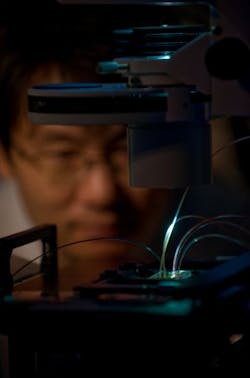Fluorescence detection method diagnoses bloodstream infection quickly
Researchers at the University of California, Irvine (UCI) have developed a new bloodstream infection test that uses fluorescence detection to speed diagnosis with unprecedented accuracy, allowing physicians to treat patients with potentially deadly ailments more promptly and effectively.
The research team, led by Weian Zhao, assistant professor of pharmaceutical sciences at UCI, developed a new technology called Integrated Comprehensive Droplet Digital Detection (IC 3D). In as little as 90 minutes, IC 3D can detect bacteria in milliliters of blood with single-cell sensitivity—and without the need for cell culture. What's more, the technology could have many applications in detecting extremely low-abundance biomarkers in other areas, such as cancers, HIV, and—most notably—Ebola, according to Zhao.
Recent molecular diagnostic methods, including polymerase chain reaction (PCR), can reduce the assay time to hours, but are often not sensitive enough to detect bacteria that occur at low concentrations in blood, as is common in patients with blood infections.
The IC 3D technology differs from other diagnostic techniques in that it converts blood samples directly into billions of very small droplets. Fluorescent DNA sensor solution infused into the droplets detects those with bacterial markers, lighting them up with an intense fluorescent signal. Zhao says that separating the samples into so many small drops minimizes the interference of other components in blood, making it possible to directly detect target bacteria without the purification typically required in conventional assays.
To identify bacteria-containing droplets among billions of others in a timely fashion, the team incorporated a 3D particle counter developed by UCI biomedical engineer Enrico Gratton and his colleagues that tags fluorescent particles within several minutes.
"The IC 3D instrument is designed to read a large volume in each measurement, to speed up diagnosis," Gratton explains. “Importantly, using this technique, we can detect a positive hit with very high confidence.”
A UCI spinoff, Velox Biosystems, is now further developing the IC 3D technology.
Full details of the work appear in the journal Nature Communications; for more information, please visit http://dx.doi.org/10.1038/ncomms6427.
-----
Follow us on Twitter, 'like' us on Facebook, connect with us on Google+, and join our group on LinkedIn
Subscribe now to BioOptics World magazine; it's free!

